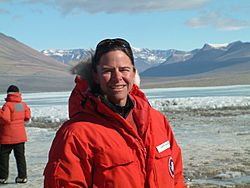Alison Murray (scientist) facts for kids
Quick facts for kids
Alison Murray
|
|
|---|---|

Alison Murray at Lake Vida
|
|
| Born |
Alison Elizabeth Murray
|
| Nationality | American |
| Alma mater | BS California Polytechnic State University MS San Francisco State University PhD University of California, Santa Barbara |
| Awards | Nevada System of Higher Education Regents Researcher Award (2014) |
| Scientific career | |
| Fields | Microbiology of polar extremophiles Microbial Oceanography |
| Institutions | Desert Research Institute |
Alison Murray is an American scientist who studies tiny living things called microorganisms. She is known for her work in the Antarctic, especially for finding life in a frozen lake. Dr. Murray studies how these tiny creatures survive and thrive in very cold and tough places. This includes environments with no oxygen or other usual energy sources. Her research helps us understand life in extreme conditions.
Early Life and Education
Alison Murray grew up in Carmel, California. She went to Carmel High School. In 1989, she earned her first degree in Biochemistry. This was from California Polytechnic State University. After that, she worked as a research assistant. This job was at the Bermuda Institute of Ocean Sciences.
She then joined a research program at Tomales Bay. Here, she earned her Master's degree in 1994. She studied Cell and Molecular Biology at San Francisco State University. During this time, she learned how to use special tools. These tools helped her identify different marine microorganisms. It was like giving them a unique "fingerprint."
Dr. Murray earned her Ph.D. in 1998. This was in Ecology, Evolution, and Marine Biology. She studied at the University of California, Santa Barbara. While working on her Ph.D., she went on two trips to the Antarctic. She studied tiny ocean creatures called plankton. She found that different types of bacteria and archaea changed a lot. These changes happened throughout the extreme Antarctic seasons.
Career and Discoveries
After her Ph.D., Dr. Murray did more research from 1999 to 2001. She worked at Michigan State University. There, she explored a new field called functional genomics. This field looks at how genes work. In 2001, she moved to the Desert Research Institute (DRI) in Reno, Nevada. She is now a research professor there.
Dr. Murray is famous for studying tiny ocean life in the Antarctic. She looks at how these creatures live and move around. She also studies how they change throughout the year. One of her biggest discoveries was finding microbial life in Lake Vida. This lake is in the McMurdo Dry Valleys of Antarctica. It is sealed under ice and is super cold, about -13°C (9°F).
Her discovery of life in Lake Vida was a big deal. News outlets like BBC TV and National Public Radio shared her findings. This research showed that life can exist in places scientists once thought were empty.
Dr. Murray's work helps us understand how microorganisms survive. They live in very cold and harsh places. Some of these places have no oxygen. Others lack usual sources of energy. She uses modern tools to study these tiny living things. Her research shows how they function and survive in extreme cold. It also shows how environmental changes affect them. This helps us understand how cold ecosystems might be impacted.
Her discoveries have changed how scientists view life in cold places. We now know that microbes in these areas are much more diverse. They also change a lot with the seasons. They can even live in places once thought impossible for life.
Her research also shows how microbes react to different environments. It explains how they help control important natural processes. This gives us a better understanding of how cold ecosystems work. It also helps us guess how they might react to big changes like climate change.
Awards and Recognition
Dr. Murray has received several awards for her important work. In 2019, she was given the DRI Science Medal. She also won the Nevada System of Higher Education Rising Researcher Award in 2009. In 2013, she received the Nevada Regents' Researcher Award.
Other Activities
Dr. Murray is also a leader in the science community. She helped lead NASA's Research Coordination Network for Ocean Worlds. From 2016 to 2017, she co-chaired the Europa Lander Science Definition team. This team planned a mission to look for life on Europa, one of Jupiter's moons.
For eleven years, she represented the U.S. in the Scientific Committee on Antarctic Research. She also played a role in the Census of Marine Life. This project aimed to count all ocean life. Today, she helps manage biodiversity data. She is part of the AntEco Scientific Research Program steering committee.

